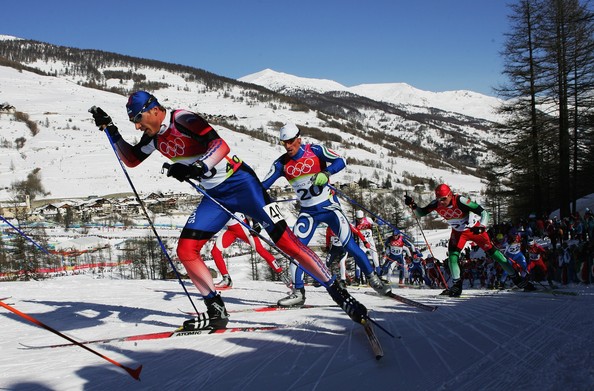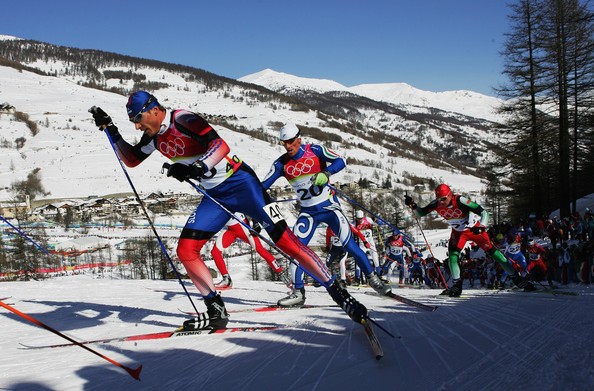To prepare for the Winter Olympics in Sochi, Russia which begin on February 6, 2014, Dear Sports Fan is running a series of previews of Winter Olympics events. So far we’ve profiled the Luge, Skeleton, Bobsled, and Ice Hockey.
All About Cross-Country Skiing

One of the charms of the Olympics is that many of the events are simply super-charged versions of common-place activities. In the Summer Olympics, no sport exhibits the chasm between Olympic athletes doing something and you doing something than the track-and-field events. Almost everyone can run 100 meters but after watching Usain Bolt do it gives you a sense for how amazing humanity can be when it puts its mind (and its legs) to it. Cross-country skiing is the Winter Olympics parallel. Although not a common form of travel in most of the United States, cross-country skiing is something most anyone can do, but not for 50 kilometers and not at a pace of fifteen miles per hour. Cross-Country Skiing in the Olympics is exhausting and exhilarating.
How Does Cross-Country Skiing Work?
- Cross-Country skiers use two main styles to race to the finish line. These two styles, classic and freestyle, are like strokes in swimming. Some races are in one style, some in another, and some mandate that skiers switch part of the way through the race. The classic style is probably what you’ve seen or done if you’ve ever come across cross-country skiing. A classic style technique as described by ski.itrundle.com is “a striding action like shuffling in socks over a polished floor, with extra momentum provided by pushing with the poles diagonally opposite to the skis..” In this style the skis stay in parallel tracks and move only forwards and backwards. In freestyle style, skiers use their skis like ice-skates and push off back and to the outside, generating more grip to propel them forwards. Each style has different optimal skis and poles, so in races that use both styles, skiers will switch skis when they switch styles. Both styles use skis that are longer and narrower than down-hill skis and poles that are longer as well. When a pack of skiers launch themselves from the starting line, they look like large insects or speedy aliens.
- Here are highlights of a men’s 30 kilometer race from the Vancouver Olympics:
- http://www.youtube.com/watch?v=yRCiO_zczas
Why Do People Like Watching Cross-Country Skiing?
- Better than Doing It: Okay, that’s a little snarky, but I do think there’s an element to watching any endurance sport which involves being mostly in awe and slightly glad that its someone else who is pushing themselves far beyond the boundary between exertion and pain. It’s incredibly to watch…
- Tactics, Tactics, Timing: Just like in cycling, strength, endurance, and a healthy pain tolerance are not enough to win, you also need good tactics and timing. In the longer races, making the right break away from the pack with the right people at the right time can set a racer up to win. And there’s not much better than the glory of a skier who goes out alone and manages to stay ahead of the pack to win or the inevitable heroic tragedy of making his or her break a little too soon and being dragged back into the pack despite all efforts to stay ahead.
- Regional Dominance: Norway and Sweden have more than 43% of all the gold medals ever awarded in Cross-Country skiing, which has been a part of the Olympics since 1924. I love it when things make sense and I love it when otherwise non-dominant sporting countries can lord over global powers. Sure, the United States and Russia might win more medals but they/we don’t dare get into a Cross-Country Skiing fight with Scandinavia!
-
What Are the Different Cross-Country Skiing Events?
There are eight Cross-Country Skiing events in this year’s Winter Olympics. They fall into three categories: individual distance races, distance relay races, and sprints. The individual distance races come in 10, 15, 30, and 50 kilometer flavors, the relays are either four by five kilometers or four by ten kilometers (four teammates, each who ski a distance before the next can start,) and the sprints are 1.5 kilometers long. There is an individual sprint and a team sprint which is like a miniature relay race with two people on a team. Both the sprints follow the pattern of track or swimming events in the Summer Olympics with heats to determine the entrants to the final medal race.
How Dangerous is Cross-Country Skiing?
Uh, well. It’s really not very dangerous. It’s so not dangerous that this was one of the top hits when I asked Google how dangerous it was. It’s a scientific paper that studied “53,000 elite male skiers” (this was done in Norway, of course) and determined that the very best skiers had the highest chance of developing heart arrhythmias.
What’s the State of Gender Equality in Olympic Cross-Country Skiing?
Of the eight Cross-Country Skiing events in the Winter Olympics this year, four are for both genders, two are for men and two are for women. The Male only events are the 50 kilometer individual ski and the 10 kilometer relay. Instead of those, the women get a 10 kilometer individual race and their relay is only five kilometers. This doesn’t make much sense because it’s fairly commonly understood that the gap between men and women in sports is less in endurance sports than power or sprint sports. Like many other events, there will be more male skiers than female.
What are Some Fun Olympic Cross-Country Skiing Stories?
Norway’s Petter Northug Jr. is the best skier in the world. He won four medals four years ago and is the favorite to get his hands on some more this time around. Anytime there’s a dominant athlete, the chances are good for excitement — either he continues his dominance (and that’s interesting because how can anyone be so much better than all these other Olympic athletes?) or someone unseats him (which is interesting because any change of power or era is interesting.)
The U.S. contingent includes a brother-sister tandem. Sadie and Erik Bjornsen of Alaska both qualified for the 14 person American team and will make the trip to Sochi together.
Important Links:
The official cross-country skiing schedule.
NBC home-page for US TV information.
The Cross-Country Skiing events begin on Feb. 8 and end on Feb. 23. They span most of the Olympic Games in Sochi.

